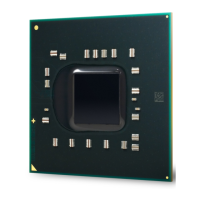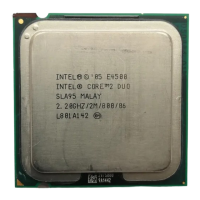Legacy Fan Speed Control
Thermal and Mechanical Design Guidelines 103
E.3 Combining Thermistor and Digital Thermal
sensor Control
There is no closed loop control between the FSC and the thermistor, but they work in
tandem to provide the maximum fan speed reduction. As discussed in Section
E.1.1,
the thermistor establishes the VSF curve. This curve will determine the maximum fan
speed as a function of the ambient temperature and by design provides a Ψ
CA
sufficient to meet the thermal profile. The FSC, by measuring the processor digital
thermal sensor will command the fan to reduce speed below the VSF curve in
response to processor workload. Conversely if the processor workload increases the
FSC will command the fan via the PWM duty cycle to accelerate the fan up to the limit
imposed by the VSF curve.
Figure 62. Digital Thermal Sensor and Thermistor
Fan Speed
(RPM)
Inlet Temperature (°C)
Full
Speed
30
38
Min.
Operating
Variable Speed Fan (VSF) Curve
Fan Speed
Operating Range
with FSC
34
Min %
Fan Speed
(% PWM Duty Cycle)
100 %
Fan Speed
(RPM)
Inlet Temperature (°C)
Full
Speed
30
38
Min.
Operating
Variable Speed Fan (VSF) Curve
Fan Speed
Operating Range
with FSC
34
Min %
Fan Speed
(% PWM Duty Cycle)
100 %
E.4 Interaction of Thermal Profile and T
CONTROL
The processor thermal specification is comprised of the two parameters, T
CONTROL
and
Thermal Profile. The minimum requirement for thermal compliance is to ensure the
thermal solution, by design, meets the thermal profile.
If the system design will incorporate acoustic speed fan control, Intel requires
monitoring the digital thermal sensor to implement acoustic fan speed control. The
value of the digital thermal sensor temperature determines which specification must
be met.
•
Digital thermal sensor less than T
CONTROL
⎯
When the thermal solution can maintain the thermal sensor temperature to
less than T
CONTROL
then the fan speed can be reduced. .
•
Digital thermal sensor greater than T
CONTROL
⎯
The T
C
must be maintained at or below the Thermal Profile for the measured
power dissipation.

